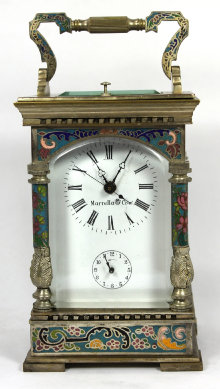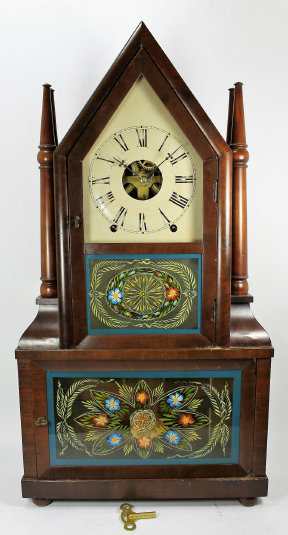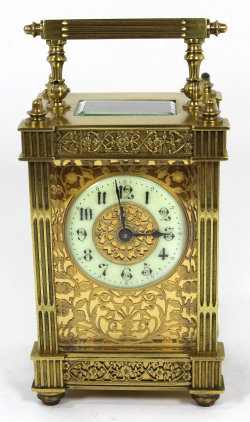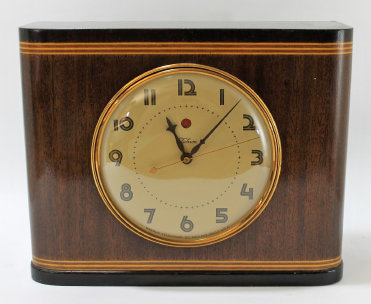


572. $125
Ansonia “Surrey”, ca. 1910. Ansonia put out a number of metal case clocks in the early 1900’s
with a “Colonial Brass Finish” and all of them have suffered the same fate over the years, with the brass finish being worn off by
excessive polishing. This one is in better shape than most, but still has its issues. You can see that it has been buffed
to a bright shine and can also see spots where the copper undercoating is showing through. There is some fine pitting on the
sides, and some spots where there is still tarnish. Shiny clocks are next to impossible to photograph and all the imperfections
seem to be magnified, so please consider that this clock looks great from a more reasonable distance. There are some scrapes
and wear to the dial, and some of the numbers have been touched up. It has an 8-day half-hour strike movement that is running
and keeping time. Sale prices for these brass clocks vary with the quality of the finish, ranging from $100 to $250.
573. $100
Chinese champlevé repeater carriage clock, ca. 1970. This multicolored enamel champlevé
carriage is 8 inches tall with the handle up. The case is silver- or nickel-plated and most of the plating is still present,
although it shows areas of tarnish that would no doubt clean up with Nevr Dull wadding polish or Simichrome. It has a white
enamel dial signed “Marrella & Co.” with trefoil hands, a seconds hand, and an alarm dial. There are four beveled, arched
glasses and a beveled glass on top over the silver platform lever escapement with jeweled pallets. The clock is running, fast,
but the strike is out of sequence and I don’t know how to adjust that. There are way too many armatures and gears in the back
to sort out. I assume it is an eight-day movement. The handle is also lost from the back door and so it’s best not to
close tightly. It’s not signed anywhere, and the country of origin is not indicated, but Bob Crowder tells us it is Chinese. It’s really quite nice and only needs a bit of polish to really make it sparkle. Two keys are included. A similar clock
in gold can be seen on page 180 of Derek Roberts’ book “Carriage and other traveling clocks”. $150-$300.


576. $1200
Birge & Fuller Candlestick Double-steeple, ca. 1844-1848. John Birge and Thomas Fuller
worked together in Bristol from 1844 until Fuller’s death in 1848. This 26-inch mahogany-veneered double-steeple holds a wagonspring-driven
signed movement. It is running and striking on the hour, but we have not gotten it to run for a full 8 days. One arm of
the wagonspring has been repaired. There are a couple of veneer chips and repairs on the upper door, barely noticeable. The candlesticks look like they might be replacements but they conform exactly to the original design; the bun feet are likely replacements. The dial is an old repaint, the hands correct. The dial glass is newer, the painted glasses are old, but both are likely repaints. I like that they match. The only real shortcoming here is the lack of label inside. The minimum is attractive; we sold
a nearly identical candlestick in September of 2015 for $2675. $1200-$1800.

574. $250
Brass carriage clock with filigree trim, ca. 1900. This standard size carriage clock
stands 6 inches high with the handle up and has a 2-inch porcelain dial with a filigree dial insert. There is a bright gold
front behind a filigree mask, with filigree side panels all behind beveled glasses. The glass in the door shows some chipping
in the corners, and there is some dried brass polish 200-behind the glasses on the sides that would clean up easily if you’re willing
to take it apart. There is no signature anywhere I can see, and no country of manufacture indicated. The key that comes
with it states “Made in England”. It is a time-only 8-day movement, and is running and keeping time. Very nice, I think. An identical carriage clock sold at Schmitt’s in 2004 for $500.
577. $50
Telechron 6B01 “The Jubilee”, 1932-38. This large electric shelf clock has an unusual
feature for a Telechron, a gong strike on the hour and half-hour – so now you could have your clock strike the hours, just like your
old mantel clock, but never have to remember to wind it! What a clever combination of old and new – and it kept perfect time
unless the power failed. Now, where to plug it in… The clock is 10.75 inches wide and 8.5 inches high. The wood
case is clean and without markings, the convex glass covers a 5.5-inch dial with a sweep seconds hand and a red dot to indicate when
power has failed. The clock is running and striking appropriately. $50-$75.
